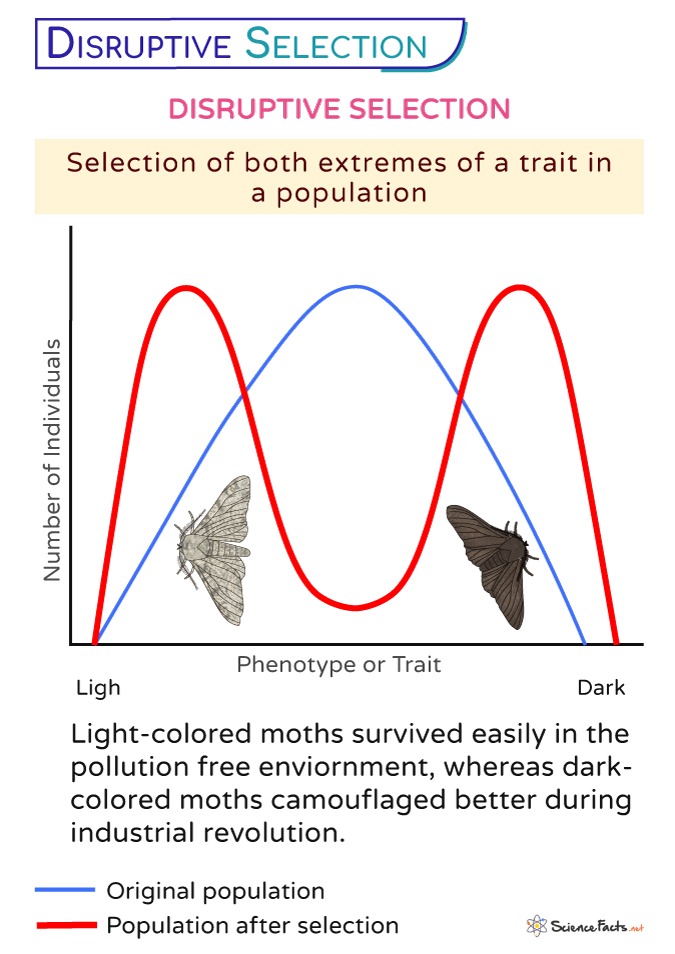Disruptive Selection
Disruptive selection is one of the three modes of natural selection (the other two being stabilizing and directional selection), where the two extreme phenotypes are selected ( a higher fitness) over the intermediate ones. In such situations, there is an increase in the variation of a trait, and the population divides into two groups. Disruptive selection is the fewest of the three types of natural selection and can often lead to speciation.
It occurs mainly due to a change in the habitat or due to scarcity of resources. Individuals with extreme traits that mate successfully with their partners can survive and pass on their genes. Such organisms are found on the two ends of the distribution curve.
Disruptive selection often leads to speciation, selecting the organisms with extreme phenotypes and removing the intermediate ones. Thus, it is also known as diversifying selection as it drives evolution. It occurs in large populations with intense competition for food and partners.
Disruptive Selection Graph
With the organisms distributed at opposite ends of a spectrum, the two bell curves are separated. There are two peaks at the extremes, with a deep valley in the middle displaying the average individuals, who are significantly fewer than the two extremes.
The typical graph of a disruptive selection is shown below:
Examples of Disruptive Selection
Disruptive selection is less common than stabilizing or directional selection in nature. However, there are many such examples.
Selection of Peppered Moths
Peppered moths in London display two different phenotypes. Those found in rural areas are almost light in color. However, the same moths are dark in color in the urban areas. Very few intermediate-colored moths are found in either location.
These selections helped the dark-colored moths to blend with the shoot-covered environment and thus avoid predation. In contrast, the predators quickly identified the light-colored ones and used them for food. In the rural areas, the light-colored moths could blend effortlessly with the environment and thus survive predation. In contrast, the dark-colored ones fall prey, causing directional selection in the peppered moths.
Selection of Rabbits
Similar to the peppered moths, disruptive selection also occurs in a hypothetical population of dark and light-colored rabbits. Black-colored rabbits survived in areas with predominantly black rocks in contrast to the light-colored ones that survived in white rock background.
Selection of Oysters
Light and dark-colored oysters have a distinct advantage in the aquatic environment compared to medium-colored ones. Light-colored oysters would seamlessly merge with the rocky terrain of the shallows. The darkest ones would perfectly blend under the shadows. The medium-colored ones have no survival advantage as they would show up in either backdrop and thus make them easier to prey upon and, therefore, are eliminated from the population.
Selection of Darwin’s Finches
During a drought in the Galapagos Islands, large and small seeds were more abundant than medium-sized seeds. It led to the evolution of two distinct beak sizes among finches: one with a small beak to efficiently eat tiny seeds and another with a large beak to crack open large seeds.
Selection of Mexican Spadefoot Toads
The two extreme body-sized spadefoot tadpoles are the most predominant compared to the average-sized ones. The round-bodied are more omnivorous, whereas the more carnivorous ones are narrow in shape. According to a study, the toads with extreme body size had additional or alternate food sources that the intermediates did not. The more omnivorous ones could feed on pond detritus, while the more carnivorous ones were better at feeding on shrimps. The intermediate ones compete with each other for food and thus cannot sustain the changing environment.
Compare and Contrast Disruptive, Stabilizing, and Directional Selections
- Disruptive or diversifying selection is natural selection, where the two extreme traits are favored over the intermediate ones.
- Stabilizing selection selects intermediate traits in a population as opposed to extreme ones. It is thus opposite to disruptive selection.
- Directional selection favors one extreme trait over another in a population.
-
References
Article was last reviewed on Tuesday, December 19, 2023




